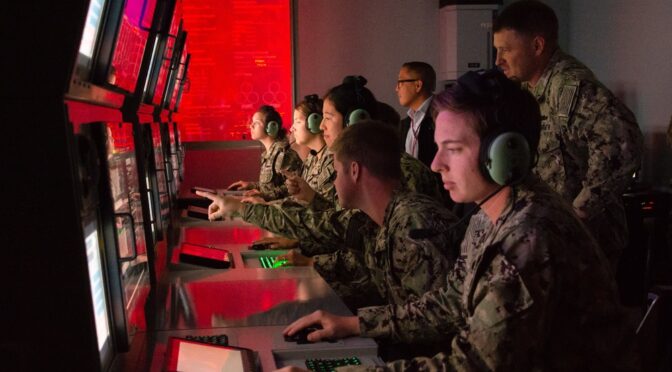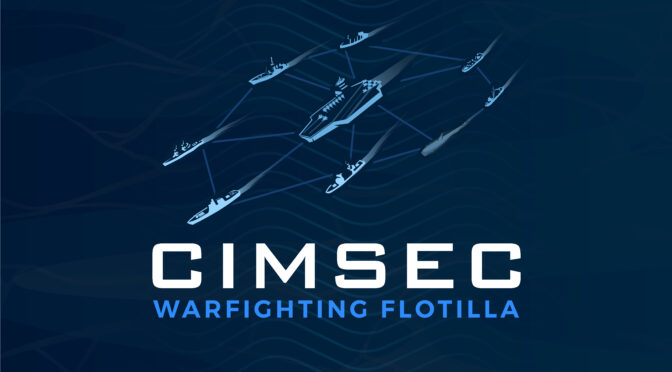By Dmitry Filipoff
CIMSEC recently engaged with the commander of the Surface and Mine Warfighting Development Center (SMWDC), RDML Wilson Marks, to discuss the latest developments and priorities of the command. In this discussion, RDML Marks discusses the new Surface Requirements Group, how SMWDC is working to better measure warfighting skill, and how the WTI program is influencing the Surface Warfare Officer career path.
SMWDC will soon be completing its restructuring and the development of the Surface Advanced Warfighting School (SAWS). What is the value of this restructuring and how will it change how SMWDC and the Warfare Tactics Instructors (WTIs) operate?
SMWDC’s restructuring promotes productivity, collaboration, and integration across all warfighting domains. Ultimately, this will enable WTIs to be more effective and efficient in their missions due to ease of information sharing and capitalization on the diversity within our organization. Similarly, in consolidating the schoolhouse at SAWS, each warfare specialty area, colloquially known as patch type, is able to gain additional feedback from every course iteration and share lessons learned at a more rapid pace. It promotes standardization of class structure, rigor in class performance requirements, and camaraderie within the cadre as we transition to subject matter experts teaching their specialty across all warfare tactics courses of instructions regardless of patch type.
How is SMWDC developing frameworks and criteria for measuring the tactical skill and watchstanding experience of warfighters? What kind of data is being collected and how may that data be used?
The team at SMWDC serves as the executive agent for Commander, Naval Surface Force’s Surface Warfare Combat Training Continuum (SWCTC) program. SWCTC is a data-driven approach to simultaneously deepen, broaden, and synergize training across the Surface Force. We are currently developing the Maritime Warfare Proficiency Model (MWP) to establish and standardize watchstanding skills using advanced data analytics to generate a numerical score for a watchstander’s level of knowledge, skill, experience, aptitude, and currency as a means of objective performance evaluation. This ultimately gives us the analytical tools necessary to continually improve individual watchstanding skills, make warfighters more lethal, and ensure our Surface Force is able to consistently demonstrate the proficiency and capability to fight and win at sea.
Within the last year, SMWDC launched the inaugural cycle of the new Surface Requirements Group (SURFRG), and also participated in a pilot program that sought to fill billets at program offices and warfare centers with WTIs. How can WTI involvement in these staffs and the SURFRG add value to the requirements and acquisition process? What can we expect from the next SURFRG cycle?
The Surface Requirements Group’s (SURFRG) primary function is to align fleet, program office, and resource sponsor (OPNAV N95/N96) efforts throughout the systems development process. It enables our WTIs to represent the challenges facing our fleet today and the challenges we are likely to face in the future. We do this by providing technical and tactical solution recommendations and divestment opportunities on near-term and future weapons, sensors, and combat system capabilities on behalf of the Surface Force.
We completed our first SURFRG cycle in August 2023 with the signing of the Technical Solution Recommendation Letter, and then in September when we briefed 15 tactical priorities to key industry partners in conjunction with the SNA West Coast Symposium. In this year’s cycle we are looking to build upon the lessons learned and successes of the inaugural cycle. We are specifically looking at streamlining the cycle while also adding more touchpoints for senior leaders and industry partners earlier in the process. We also have three WTIs working at Program Executive Office Integrated Warfare Systems (PEO IWS) who are working alongside the project managers to bring their high level of tactical expertise to enhance our future warfare systems. At the same time, they gain acquisition and project management expertise from some of the best personnel in our Navy. It is a true win-win arrangement.
The war in Ukraine has featured high-profile naval combat operations, including the sinking of the cruiser Moskva, exploding unmanned surface vessels attacking warships, and naval mining and blockades. How is SMWDC processing lessons learned from the conflict’s naval operations, and what are some key takeaways?
We work closely with the fleet commanders to capitalize on any information they receive and compare that against our tactics, techniques and procedures (TTPs) for possible improvements or needs to write new ones. For example, our team at the SMWDC Mine Countermeasures Technical Division (MCMTD) is using the information we receive to think through the ways we need to approach any mine clearance effort. While we are taking a look at the details we have available to us now, the nature and extent of the mining efforts employed by both sides will only be clearly understood when the conflict is complete. However, what we can learn from this conflict is that naval mines are still relevant. We are working hard to ensure that our Navy is better informed about this low cost, asymmetric weapon in the maritime domain and about the types of mine countermeasures capabilities and technologies that we need to invest in to be able to conduct mine countermeasures in the future.
The navies of other great powers possess considerable capability and their own unique doctrine and tactics, especially the Chinese Navy. How is SMWDC enhancing the surface fleet’s literacy in “Red” capabilities and doctrine? Does SMWDC have plans for assigning WTIs to dedicated adversary roles, such as red cells, OPFOR units, or aggressor staffs?
SMWDC is working closely with both the Navy’s and national intelligence communities to improve the Surface Force’s understanding of current maritime threats. SMWDC provides “Red” threat presentations through a series of in-port training sessions for prospective commanding officers, plans and tactics officers, and future WTIs. We have also enhanced the threat presentation offered underway during Surface Warfare Advanced Tactical Training (SWATT) events to align to the current pacing maritime threats units can expect to encounter on deployment. While we do not assign WTIs to dedicated adversary roles, we do have “communities of focus” based on mission areas to allow a greater depth of understanding and competency. This provides us the ability to create tactical and operational advantages in our TTPs to enable victory in any conflict.
Concepts such as Distributed Maritime Operations (DMO) and joint fires are deeply cross-cutting and combined arms methods of warfighting. How is SMWDC partnering with the Navy’s other warfighting development centers, and entities from the other services, to refine these methods?
SMWDC maintains close and consistent contact with the other Warfighting Development Centers (WDCs). In October, we hosted the semi-annual Warfighting Development Center Leadership Huddle and Advanced Warfighting Seminar on behalf of the Navy Warfare Development Center, allowing each WDC commander to educate their peers on the unique capabilities and challenges each center has in operationalizing Distributed Maritime Operations. In addition to those command-level engagements, the WDCs have touchpoints for mutually supporting joint exercise and wargame planning.
At SMWDC, we have created a Surface Warfare Integration Office (SWIO) staffed by talented WTIs who support these events. The SWIO team works with other services to enhance our interoperability during SWATT, preparing Surface Forces for the joint and high-end fight. Additionally, our Mine Countermeasures Coordination Group enjoys consistent and valuable participation from our Marine Corps partners and the Undersea Warfighting Development Center. The future fight will be enormously complex, and the DMO framework requires the capabilities of all the services at the right time and place to deliver the necessary effects. Partnering and planning with all of the WDCs and other services is a normal part of our daily practice to make the fleet more lethal in an all-domain, joint fight.
After becoming a WTI and completing a production tour, what are the possible downstream effects on a SWO’s career? How is the WTI program influencing the incentives and milestones of the SWO career path?
Becoming a WTI is one of the most career-enhancing choices a young officer can make. Our WTIs screen for department head at 100 percent and exceed the selection rates of non-WTIs for commander command and major command. The team at PERS is working closely with SMWDC to ensure we are applying the subject matter expertise where it makes sense across the fleet and in line with the needs of the officer. We have also added the additional qualification designator (AQD) of KWC to a WTI’s record at the completion of a production tour. Having the KWC designator indicates a level of knowledge of not just the WTI course of instruction, but also continued professional development and experience gained in their associated WTI production tour. This allows us to fill billets at commands looking for this level of expertise within an integrated warfighting environment in places like SMWDC, the Program Executive Office Integrated Warfare Systems, and other tactical commands as availability allows. None of this is limiting to a SWO’s career choices, and we continue to provide flexible, challenging, and career-enhancing opportunities to our WTIs. Our top priority is to make the fleet more lethal and our WTIs are the key to our success.
Rear Admiral Wilson Marks graduated from the U.S. Naval Academy in 1994 with a Bachelor of Science in History. He has also earned a Master of Arts in National Security Affairs in Strategic Studies from the Naval War College and a Master of Science in National Strategic Studies from the National War College. Marks commanded USS Mason (DDG 87), USS Robert Smalls (CG 62) formerly named USS Chancellorsville, Provincial Reconstruction Team Ghazni Province, Afghanistan, and Naval Surface Group Western Pacific. Ashore, he served as a Placement Officer and Assistant Captain Detailer at Naval Personnel Command, Executive Assistant to the commander of Naval Surface Force Atlantic, the Deputy for Combat System and Warfighting Integration at the Office of the Chief of Naval Operations, and as the Executive Assistant to the commander of U.S. Pacific Fleet. Marks assumed the role of Commander, Naval Surface and Mine Warfighting Development Center in May 2023.
Dmitry Filipoff is CIMSEC’s Director of Online Content. Contact him at Content@cimsec.org.
Featured Image: Naval Surface and Mine Warfighting Development Center (SMWDC) and Center for Surface Combat Systems (CSCS) host advanced Anti-Submarine Warfare Officer (ASWO) students for hands-on training inside of CSCS’s Combined Integrated Air & Missile Defense/ Anti-Submarine Warfare Trainer (CIAT). (U.S. Navy photo by Clinton Beaird/released.)



